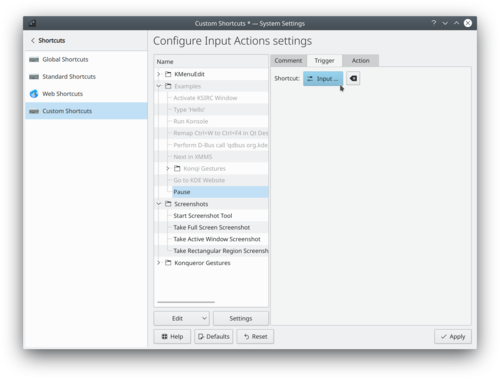Tutorials/hotkeys/fr: Difference between revisions
(Created page with "* appeler la commande <code>systemsettings</code>") |
(Created page with "* presser la touche <keycap>Pause</keycap>") |
||
| Line 13: | Line 13: | ||
* In the <menuchoice>Trigger</menuchoice> tab, click on <menuchoice>None</menuchoice> | * In the <menuchoice>Trigger</menuchoice> tab, click on <menuchoice>None</menuchoice> | ||
* | * presser la touche <keycap>Pause</keycap> | ||
* go to the <menuchoice>Action</menuchoice> tab | * go to the <menuchoice>Action</menuchoice> tab | ||
Revision as of 08:42, 11 April 2018
Avec KDE vous pouvez faire en sortie que n'importe quelle touche ou une combinaison de touches déclenchent une action sur votre ordinateur. Par exemple : quand je fais une "pause" lors de mon travail je veux verrouiller mon écran afin que mes collègues ne puissent pas me taquiner dans ma session d'utilisation. Voici comment faire cela.
- appeler la commande
systemsettings
- select and enter
Pause
- In the tab, click on
- presser la touche Pause
- go to the tab
- enter
qdbus org.kde.screensaver /ScreenSaver org.freedesktop.ScreenSaver.Lock
or (whatever works)
/usr/lib64/kde4/libexec/kscreenlocker_greet
or (whatever works)
/usr/lib64/kde4/libexec/kscreenlocker --forcelock
- click
- test it by pressing the Pause key

